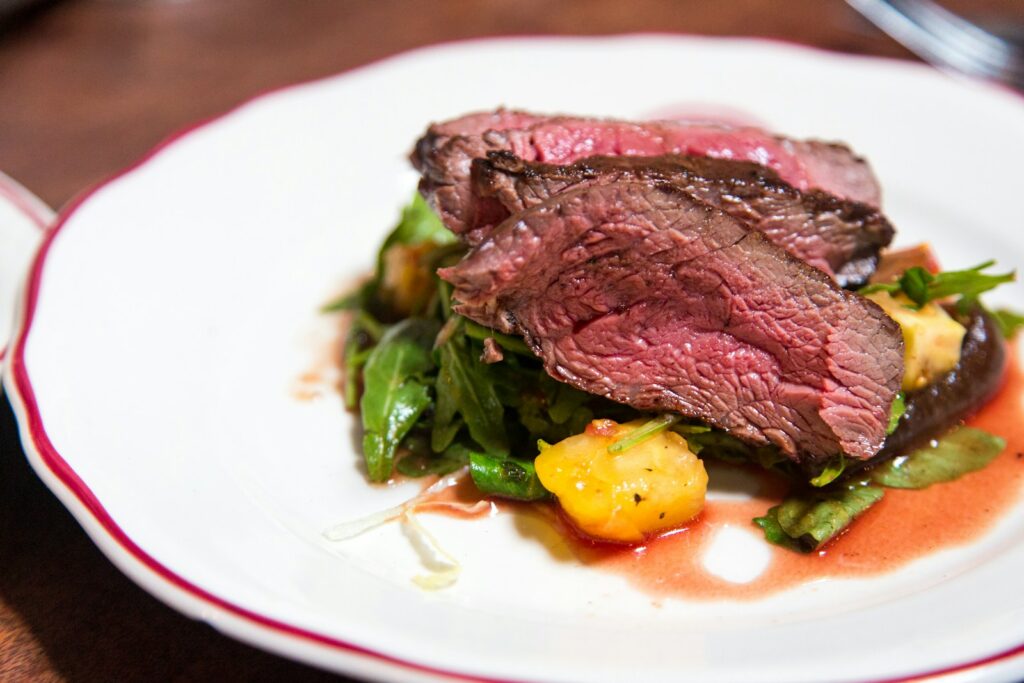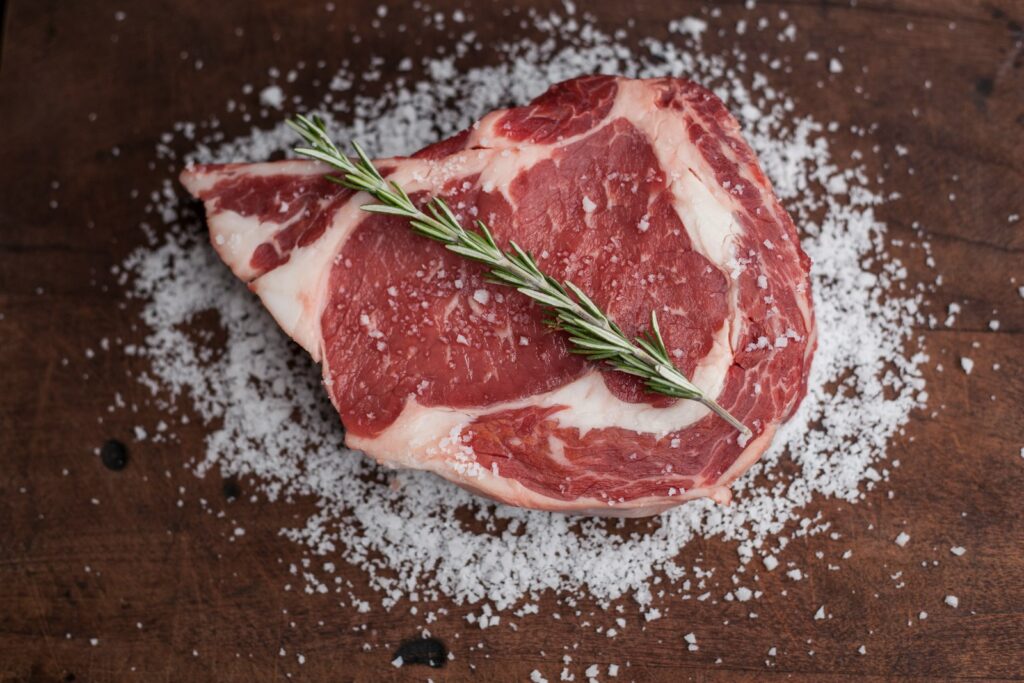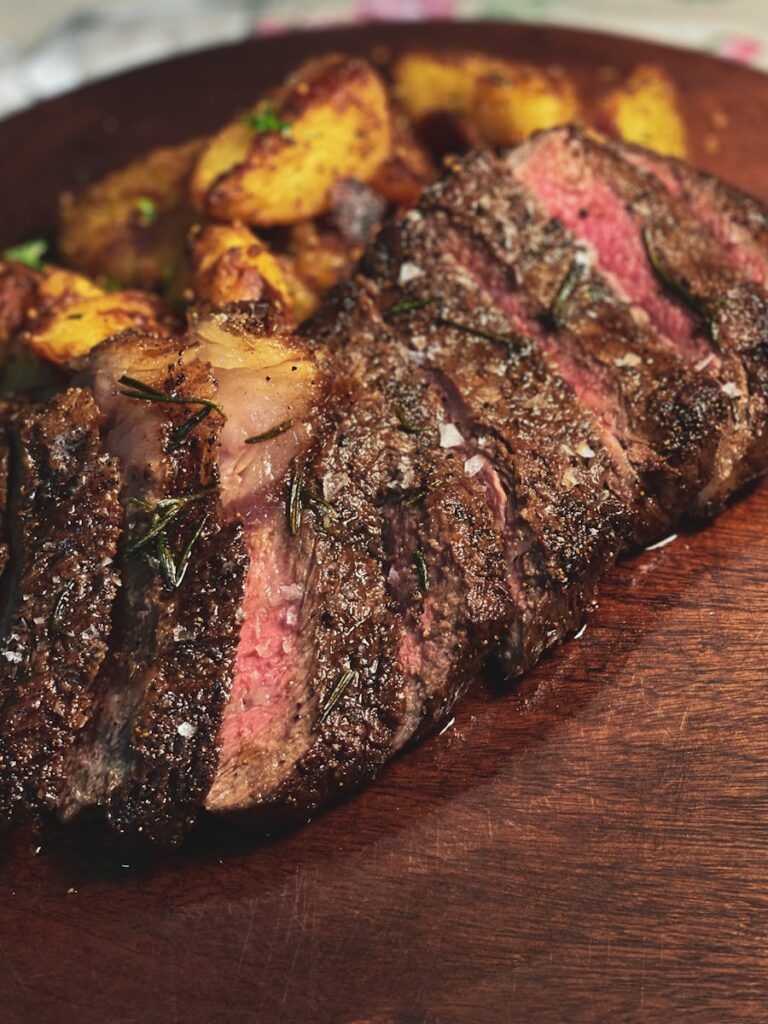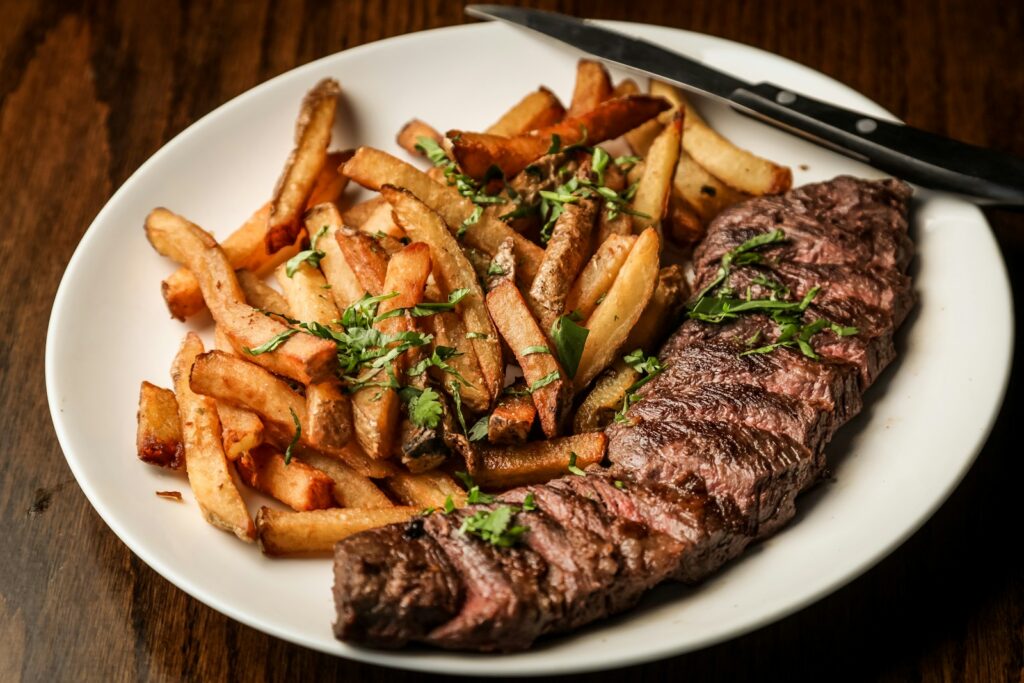Frites with steak! The phrase itself evokes images of cozy, lamplit bistros in Paris, where the aroma of seared steak and freshly fried potatoes entices the senses and conversation reverberates. This classic dish, a popular staple in France and other nations, embodies the elegant simplicity of French cooking—a harmonious fusion of flavors, textures, and cooking techniques that has stood the test of time.
Consider a frigid night in Paris, near the Champs-Elysée, if you will. The café you’ve selected for the evening has a whimsical touch thanks to the lingering Christmas decorations. Your server comes over as you become comfortable with the atmosphere, and you place your order for the famous steak frites. A curveball, however, follows: “Quelle cuisson votre viande? Bleu? Saignant? “A point?” This question may trigger a moment of terror for those who are unfamiliar with it. Don’t worry, though, since with a little education, you can master the art of ordering steak in France.
Cooking steak to a range of doneness levels, each with its own name, is a skill that the French have perfected. ‘Bleu’ implies a steak that is seared on the outside but raw and virtually uncooked inside;’saignant’ indicates a rare, bloody, and wonderfully tender cut; and ‘À point’ is the golden medium rare that many people strive for. Furthermore, ‘Bien Cuit’ signifies well done, which can raise some eyebrows at a French cafe, and ‘Cuit’ implies medium if you prefer your steak a wee bit more done.

The sauce selection enhances the steak frites experience even more. I enjoyed steak served with two delectable sauces, Graine de Moutarde, and Béarnaise, during a memorable evening at L’Etoile 1903, a traditional French cafe close to the Arc de Triomphe. Anyone who wants to appreciate steak frites to the fullest must try these sauces, which I learned at École des Trois Ponts, a language and cookery school west of Lyon. An excellent sauce can turn a fine steak into a memorable supper, whether it’s the creamy richness of Graine de Moutarde or the tangy kick of Béarnaise.
However, what about the actual steak? The cut selection is very important. While classic cuts like the New York strip or rib-eye are still popular, new modern cuts have appeared as French cuisine has developed. The choice of the proper cut gives the meal depth and character, whether it’s the grass-fed sirloin that’s popular at Melbourne’s Entrecôte or the flavorful bavette, onglet, and tri-tip that’s popular at Sydney’s Whalebridge. It is evidence of how steak frites may be made to suit a wide range of palates and tastes.
I have found a family version recipe for cooking this dish after enjoying the restaurant’s French Steak Frites, which can be experienced by more people.

Ingredients
- 1 teaspoon vegetable oil, or as needed
- 2 hanger steaks
- 2 tablespoons minced shallot
- ¼ cup dry white wine
- ¼ cup beef broth
- 2 anchovy fillets, chopped, or more to taste
- 3 tablespoons butter
- 1 tablespoon minced fresh parsley
- 1 tablespoon minced fresh chervil
- 1 teaspoon minced fresh thyme
Directions
- Heat vegetable oil in a heavy skillet over medium-high heat. Cook steaks to desired doneness, about 5 minutes per side for medium; an instant-read thermometer inserted into the center should read 130 degrees F (54 degrees C). Transfer steaks to a plate to rest.
- Place shallots in the skillet and cook until beginning to soften, about 2 minutes. Pour wine into the skillet and bring to a boil while scraping the browned bits of food off of the bottom of the pan with a wooden spoon. Add broth and anchovy; cook until thickened to sauce consistency, 2 to 3 minutes. Remove skillet from heat; whisk butter in gradually. Stir parsley, chervil, and thyme into the sauce. Purée sauce in the skillet with an immersion blender until smooth.
- Cut steaks into thin slices across the grain; spoon sauce over slices.
The recipe is from: https://www.allrecipes.com/recipe/246296/parisian-style-steak-frites/

The ‘frites’ in steak frites are definitely not to be dismissed. These fries require a lot of love; often, they are double-fried to attain the optimum level of crunch on the exterior and a soft, fluffy interior. Making frites demands the same level of care and attention to precision as cooking a steak, displaying the devotion to quality and accuracy that lies at the heart of French culinary tradition.
French food emphasizes quality, simplicity, and the pleasure of eating, and steak frites are a fantastic example of this. This dish displays the ingenuity of cuisine and the search for excellence. Steak frites continue to satisfy customers’ palates and hearts whether they are served in a fashionable restaurant in Sydney or Melbourne, a crowded bistro in Paris, or a quaint café in Lyon.

The next time you’re in a French cafe pondering the menu, use the moment to enjoy steak frites in all their splendor. Prepare to be fascinated by the depth of taste and texture that make steak frites a genuine culinary masterpiece by bearing in mind the tips and information provided here and confidently picking the doneness degree you prefer. Savor your dinner!
Related posts:
Ordering Steak Frites Like The French
A deep dive into steak frites – hospitality
Steak Frites



